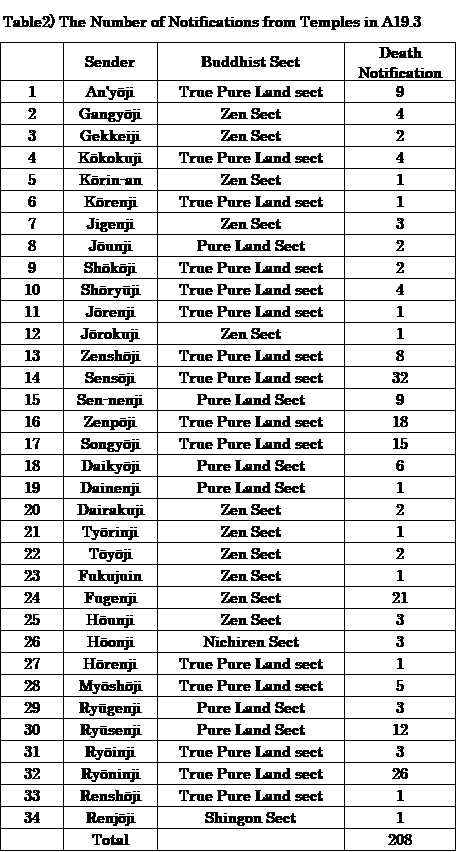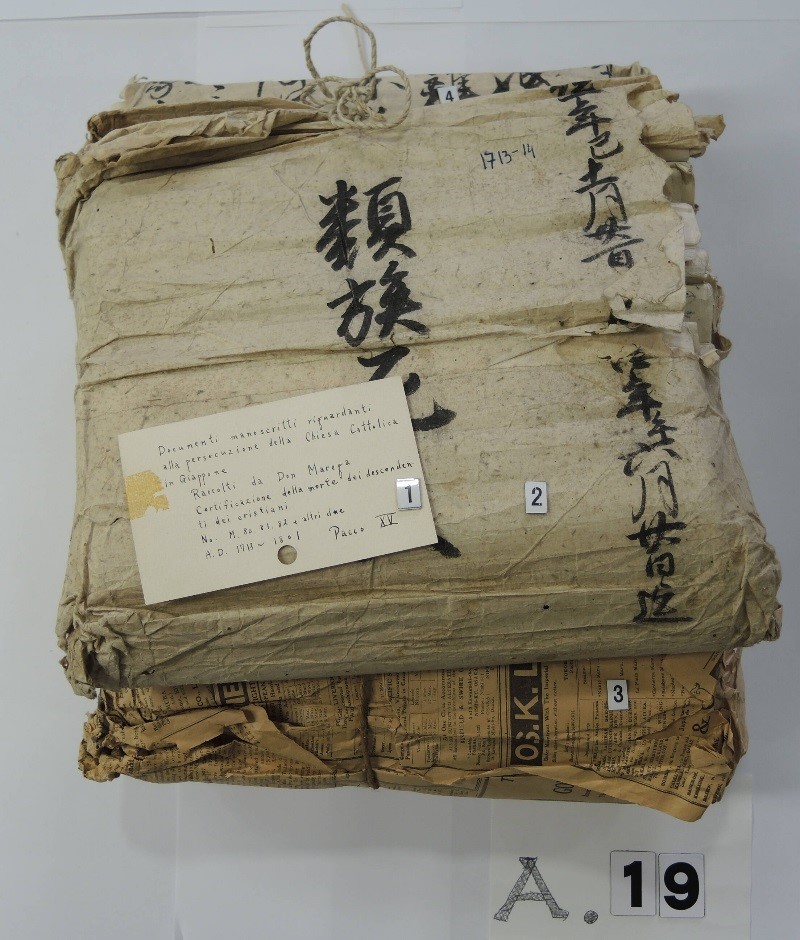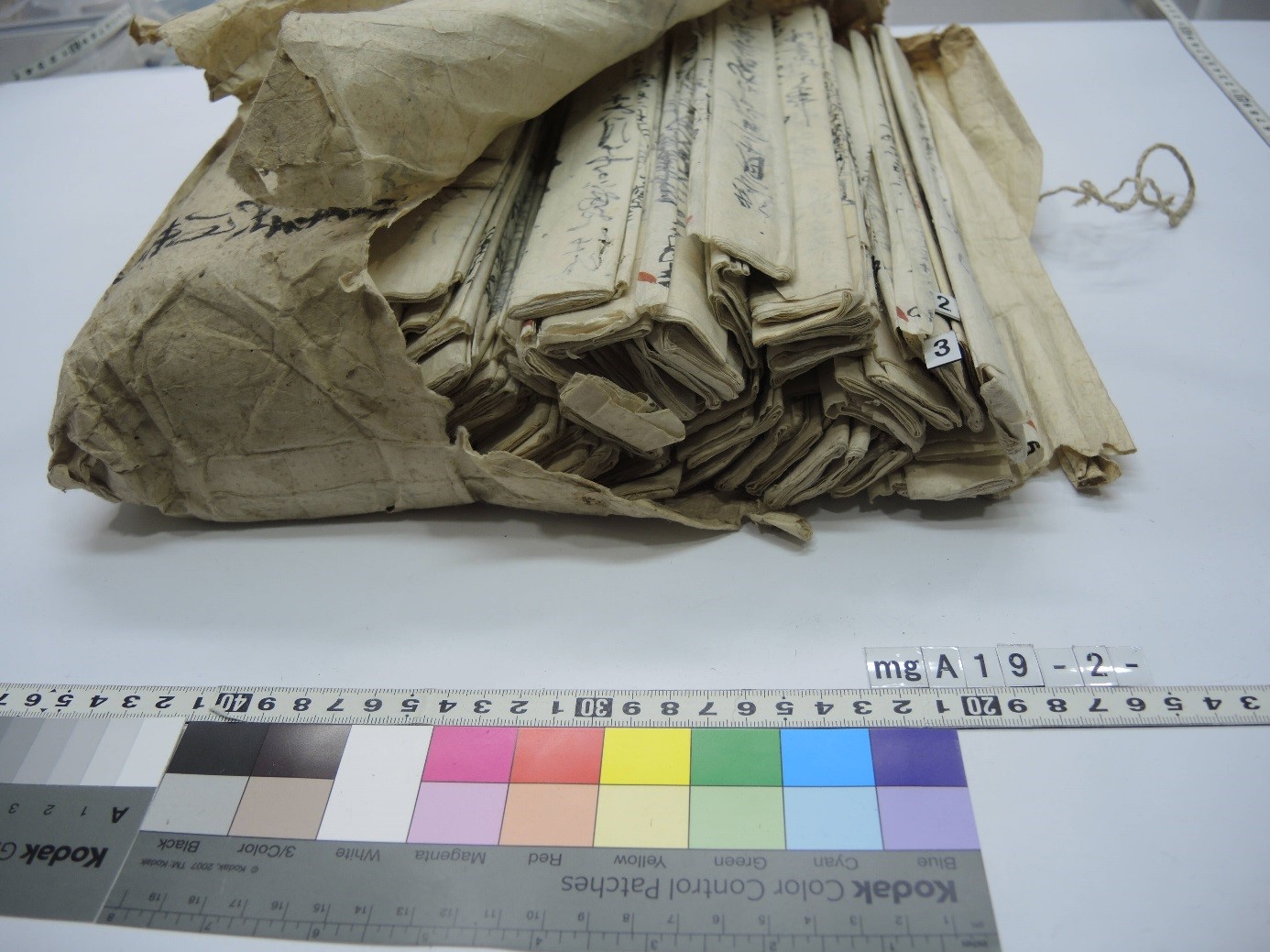- Reference Code
maregaA19
- Title
Fonds Marega File A19
- Date Range
- 1697, 1713, 1714, 1718, 1719, 1721
- Primary Date Range
- 1713, 1714, 1718, 1719, 1721 (excluding one item for which year is unclear and koyori 紙縒)
- Date Range Notes
- 1697 (Genroku 10), 1713 (Shōtoku 3), 1714 (Shōtoku 4), 1718 (Kyōhō 3), 1719 (Kyōhō 4), 1721 (Kyōhō 6)
- Description Level
File
- Quantity
- A19.1–1 record (1 card), A19.2–376 records (370 komonjo 古文書, 1 paper bag, 2 koyori, 1 fragment explaining group of historical documents, 2 wrappers), A19.3–433 records (428 komonjo, 1 koyori, 1 paper bag, 1 newspaper, 1 tsutsumi gami ツツミ紙, 1 koyori), A19.4–210 records (201 komonjo, 1 paper bag, 8 koyori)
- Notes on Physical State
A19 is comprised of a card (A19.1) and three groups of historical documents (A19.2, A19.3, A19.4).
A19.2 is comprised of historical documents relating to the death of ruizoku 類族 (descendants of Christians). They were placed in a paper bag (A19.2.0) on which is written “Deceased ruizoku from the twenty-first day of the eleventh month of 1713 (Shōtoku 3), year of the snake, to the twentieth day of the sixth month of 1714 (Shōtoku 4), year of the horse.” As this indicates, the materials were created between 1713 to 1714. One also finds “1713–14”.
The A19.3 group of documents was placed in a paper bag on which is written “Ruizoku deaths, the twenty-first day of the sixth month of 1721 (Kyōhō 6), the year of the ox, to the twentieth day of the eleventh month of Kyōhō 6.” This bag was wrapped in packing paper and then wrapped with the English edition of the newspaper The Osaka Mainichi & The Tokyo Nichi Nichi (02/26/1938). This was then tied with twine. The forty-seven A19.3.2 documents were tied together with koyori inside the bag. Others were folded together shigai aratame shōmon 死骸改証文 (corpse inspection certificates) issued by temples and villages regarding the same death. However, in the case of the A19.3.1.61 corpse inspection certificate from the temple Hōonji, there was no document from the village.
The group of A19.4 documents was placed in an Edo period bag on which the following was written: ruizoku kongi 類族婚儀 tokorogae shōmon 所替証文 [certificates for descendants of Christians regarding marriage and moving], yōshi 養子 ribetsu 離別 teihatsu 剃髪 [notifications regarding the adoption, the severing of family relations, and tonsure], gojikisan hōkōnin tsuketodoke 御直参奉公人附届 gokachū matawa hōkōnin 御家中又者奉公人 [notifications regarding servants], kanai hikkoshi 家内引越 deiri tsuke todoke shōmon 出入付届証文 [notifications regarding retainers moving], and kuzureya 崩家 shōya yuzuri shōmon 庄屋譲証文 [notifications regarding discontinued families and new village representatives] from the twenty-first day of the eleventh month of 1718 (Kyōhō 3), the year of the dog, to the twentieth day of the sixth month of 1719 (Kyōhō 4)
The documents in this bag (excluding two documents) were divided into eight smaller groups with koyori.
- Provenance / Creation
- Father Mario Marega. The komonjo are originally from Usuki Domain’s Office of Religious Affairs (shūmonkata 宗門方).
- Biographical History
- Same as fonds
- Place Name
- Usuki City and Ōita City, Ōita Prefecture; Himon’ya, Meguro City, Tōkyō-to
- Positions, etc
- Salesians of Don Bosco missionary
- Archival History
- Donated to the Vatican in 1953 by Mario Marega.
- Acquisition Source
- Same as fonds.
- Scope and Content
A19.1 is a book card with an explanation in Italian regarding the A19.2 to A19.4 historical documents: “Documenti manoscritti riguardanti alla persecuzione della Chiesa Cattolica in Giappone,” “No. M.80.81.82 e altri due,” and “A.D.1713~1801.”
The shishitsu shōmon 死失証文 (death notifications) regarding ruizoku, which form the majority of A19.2’s documents, are as follows: (1) 176 documents submitted by village / town officials and five household units, (2) four documents submitted by samurai, (3) two documents conveying information from shogunate domains to which people moved, and (4) 182 documents submitted by temples. Five of (4) were sent from temples in Edo. The shigai aratame shōmon issued upon the death of ruizoku appear to generally have been stored as sets (one from villages/towns and samurai and the other from temples) at the Office of Religious Affairs. In A19.2 we find (1) materials indicating the existence of a ruizoku temple family (A19.2.9.1, A19.2.9.2, A19.2.158.1, A19.2.158.2), (2) materials indicating the follow-up system in place for the death of someone related to a village representative (A19.2.10.1, A19.2.124.1), and (3) salt preservation measures used upon the death of a honnin dōzen 本人同然 (someone born to a Christian before their renunciation) (A19.2.96.7.1, A19.2.96.7.2). Notably, A19.2.9.1 and A19.2.9.2 in (1) indicate that when the temple Ryōninji was opened in Notsu Kibino Village, Genjun’s wife, a korobi kirishitan 転切支丹 (former Christian), played a central role in converting Christians to Buddhism. Also, A19.2.158.1 and A19.2.158.2 indicate that the wife of the former head priest of the Notsu temple Shōkōji was a kirishitan shūmon korobi honnin dōzen 切支丹宗門転本人同然 (the spouse of a former Christian or the child of a former Christian born before renunciation). These documents provide interesting information for examining how Christianity had spread in a village society.
In A19.3 are included eight birth notifications unrelated to the writing found on the bag. Seven of them were in A.19.3.1.2, which was tied together with a koyori 紙縒. Six of them appear to have been grouped together with shigai aratame shōmon (one from the village, one from the temple) due to the child’s early death. There were two cases of more than a month passing between the birth and death of the child, the longest period between birth and death out of the eight documents here. Two of the birth notifications do not include a shigai aratame shōmon. It is unclear why these birth notifications were included in this group of historical materials on their own. The eight birth notifications in this group of historical materials are as follows (see Table 3):
1.Grouped with a shigai aratame shōmon A19.3.1.2.3.3 / A19.3.1.2.13.2 / A19.3.1.2.14.2 / A19.3.1.2.16.2 /A19.3.1.2.19.2 / A19.3.1.2.21.2 2.Stand alone, without a shigai aratame shōmon A19.3.1.2.17 / A19.3.1.90
The village representatives / temples that issued shigai aratame shōmon, as well as the numbers of them, are found in the below two tables (Table 1, Table 2). There were forty-three village representatives that issued these certificates, and thirty-four temples that did so.
All documents in A19.4 are reports submitted to the Usuki Domain’s Office of Religious Affairs by the domain’s village officials or heads of samurai family units. As is written on the front side of their bag, they cover a variety of developments related to ruizoku (see below table). It appears that all developments, besides those involving an increase/decrease in the ruizoku population (birth, death), are covered. Documents related to marriage, adoption, severing of family relations, and moving were submitted by officials of the villages, etc., of both parties involved. It appears that the Usuki Domain’s Office of Religious Affairs rolled up these two reports together.
Excluding two 1697 (Genroku 10) reports and one other report (date unclear, year of the rooster), all of the documents fall within the Edo period time span written on the front of the bag (the twenty-first day of the eleventh month of Kyōhō 3 / 1718 to the twentieth day of the sixth month of Kyōhō 4 / 1719). It thus appears that the current state of these documents heavily reflects the Usuki Domain Office of Religious Affairs’ organization and management of them.
While this group of documents is divided with koyori into eight sub-groups, these sub-groups are not based on their month of submission or content. It is unclear whether these subgroups were created by the office.
- Languages Used
- Italian - 1, English 1, Japanese - 1006 (komonjo, koyori, wrappers)
- Date Description Written
- 2018/10/01
- Reference Images







